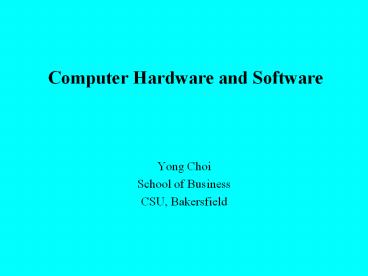Computer Hardware and Software PowerPoint PPT Presentation
Title: Computer Hardware and Software
1
Computer Hardware and Software
- Yong Choi
- School of Business
- CSU, Bakersfield
2
Computer Hardware
- Comprehensive term for all the physical parts of
a computer - Tangible things that you can actually touch and
feel - disks, monitors, keyboards, printers, boards,
speaker, and chips. - Falling price of HW
- Technical driving force of the Information Age
3
Computing Power
- Faster
- Cheaper (PC less than 500)
- Smaller
- Shorter computer product life cycle
4
Storage
- Price of 1 MB hard drive space
- 1983 - 300
- First PC in 1981
- Early IBM PCs have 20 - 30 MB
- 1989 - 2, 1997 - .07, and today minimal
- Megabyte (MB) about 1 million bytes
- Gigabyte (GB) about 1 billion bytes
- Terabyte (TB) about 1 trillion bytes
5
Transmission
- I hr satellite teleconferencing
- 1985 - 100
- 1998 - less than 10
- Today - minimal
- Internet dial-up service
- 1997 AVG. 40
- DSL less than 15
6
Hardware Trend
- More Multimedia Oriented.
- graphics, picture, sound, voice, video clip
- DMB
- Smaller, Smarter.
- Tablet PC (i.e., ipad), Smart phone
- More powerful
- Massive parallel (process many tasks
simultaneously) - many networked CPUs vs. many tasks
7
Computer Software
- Intangible untouchable
- Written in various computer program languages
- C, Java, VB.NET....
- Set of instructions that hardware executes to
carry out a specific task for you - Changing of SW price
- More important than HW
- Y2K
8
Two Major Categories of Software
- Application software enables you to solve
specific problems or perform specific tasks
APPA-8
9
Two Major Categories of Software
- System software handles tasks specific to
technology management and coordinates the
interaction of all technology devices - Two main types of system software
- Operating system software
- Utility software
APPA-9
10
Types of System Software
- Operating system software controls application
software and manages hardware devices - Utility software provides additional
functionality to your operating system - Anti-virus
- Screen saver
- Etc.
APPA-10
11
GUI vs. Command Driven
- DOS vs. Windows (i.e., XP, Vista..)
- User training
- Productivity
- Technical Compatibility
12
Demo of Command Driven
- Start ? programs ? accessories ? command prompt
- Try to delete sylacct360.ppt PowerPoint file
from desktop (download and save the PPT file
first) - dir
- cd my documents or desktop (not case sensitive
but space) - dir (to see available files)
- del sylacct360.ppt (dont forget the file
extension) - dir
13
SW Considerations
- Compatibility with current software
- Outsourcing
- Off-the-shelf software
14
More about computer
- picotux - the smallest Linux Computer in the
World
15
Six Categories of Hardware
Video card (connecting)
Keyboard (input)
CDs (storage)
CPU
Cable modem (telecommunications)
Monitor (output)
APPA-15
16
COMPUTER CATEGORIES (BY SIZE)
PDA
Notebook
Tablet PC
Desktop
APPA-16
17
CPU and RAM
APPA-17
18
CPU and RAM
- CPU and RAM work together to form the brain of
your computer - CPU speed measured in gigahertz (GHz)
- GHz number of billions of CPU cycles per second
- CPU (machine) cycle retrieve, decode, and
execute instruction, then return result to RAM if
necessary
APPA-18
19
CPU Components
- Control unit directs what happens in the CPU
and the rest of your computer - Arithmetic logic unit (ALU) performs
arithmetic, comparison, and logic operations - CPU cache CPU memory where instructions wait
until theyre needed - CPU clock beats to keep instructions and
information moving in synchronized fashion
APPA-19
20
System Bus
- System bus electrical pathways that move
information between motherboard components,
especially between CPU and RAM
APPA-20
21
CPU and Ram at Work
APPA-21
22
CPU (Machine Cycle)
- Retrieve The control unit sends to RAM for the
instructions and information it needs - Decode CPU gets the instruction out of cache and
examines it to see what to do - Execute Does what the instruction says to do
- Store Sends the result of processing to be
stored in RAM if necessary
APPA-22
23
Notebook CPUs and RAM
- Mobile CPU type of CPU that changes speed, and
therefore power consumption, in response to
fluctuation in use - RAM for notebooks comes in smaller modules than
RAM for desktops
APPA-23
24
COMPUTER CATEGORIES (BY SIZE)
Minicomputers
Mainframe
Supercomputer
APPA-24
25
Common Types of Flash Memory
APPA-25
26
CPU and RAM
APPA-26

